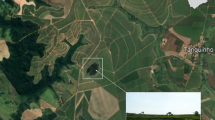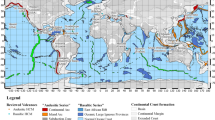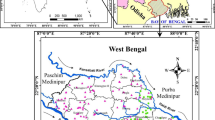Abstract
Discharge-area groundwater in Jinan, a typical karst region in northern China, was investigated by studying both the hydrological and chemical processes evolving from the recharge in mountainous terrains to the karst-spring outflows in the metropolitan area. Large-scale exploitation of karst groundwater has led to a disturbing trend in the ever-decreasing spring outflow rates and groundwater level. There is insufficient information about the Jinan karst aquifers, which provide the main water sources to meet human demand and to sustain spring outflow. The coupling of hydrological and chemical processes quantifies the flow system through aqueous chemistry characterization of the water sources. This approach is used to study the groundwater flow discharges in different locations and geological settings. The potentiometric data indicated limited vertical connectivity between distinct hydrogeological units and alteration of the recharge regime by the faults and by artificial exploitation. Shallow groundwater primarily belongs to the local flow system, with high nitrate concentration and enriched stable isotopic contents. Thermal groundwater has high concentrations of chloride and total dissolved solids, derived from a regional flow system with the highest recharge altitudes and long residence time. Non-thermal karst water may be attributed to the intermediate flow system, with uniform HCO3–Ca(Mg) facies and low nitrate concentration. This work highlighted discharge as a fingerprint of groundwater flow conditions and provides a better insight into the hydrogeological system.
Résumé
L’eau souterraine de la zone de décharge de Jinan, une région karstique typique dans le nord de la Chine, a fait l’objet d’une recherche par le biais d’une étude conjointe des processus hydrologiques et chimiques qui se développent de la zone de recharge dans les terrains de montagne jusqu’aux émergences de sources karstiques dans l’aire métropolitaine. L’exploitation à grande échelle de l’eau souterraine du karst a conduit à une tendance alarmante de diminution ininterrompue du débit des sources et du niveau piézométrique des eaux souterraines. Il n’y a une information insuffisante concernant les aquifères karstiques de Jinan, qui constituent les ressources en eau principales pour répondre à la demande en eau potable et pour assurer le soutien du débit des sources. Le couplage des processus hydrologiques et chimiques quantifie le système d’écoulement grâce à la caractérisation de l’hydrochimie des ressources en eau. Cette approche est utilisée pour étudier la décharge de l’écoulement d’eau souterraine dans des localisations et des contextes géologiques différents. Les données de charges hydrauliques ont indiqué une connectivité verticale limitée entre les unités hydrogéologiques distinctes et une perturbation du régime de recharge par les failles et par l’exploitation artificielle. Les eaux souterraines peu profondes relèvent essentiellement du système d’écoulement local, avec une concentration élevée en nitrate et un enrichissement en isotopes stables. L’eau souterraine thermale a des concentrations élevées en chlorures et en matières dissoutes totales, provenant d’un système d’écoulement régional avec des altitudes de recharge les plus élevées et de long temps de séjour. L’eau non-thermale du karst peut être attribuée à un système d’écoulement intermédiaire, avec un faciès uniforme de type HCO3–Ca(Mg) et une concentration faible en nitrate. Ce travail fait clairement apparaître la décharge comme l’expression des conditions d’écoulement souterrain et fournit un meilleur aperçu du système hydrogéologique.
Resumen
Se investigó la descarga del agua subterránea en la zona en Jinan, una típica región kárstica del norte de China, para estudiar tanto los procesos hidrológicos como los químicos desarrollados en la recarga en terrenos montañosos en las salidas de los manantiales kársticos en el área metropolitana. La explotación a gran escala del agua subterránea kárstica ha dado lugar a una tendencia preocupante por la continua disminución de los ritmos del flujo de salida de los manantiales y del nivel del agua subterránea. No hay información suficiente sobre los acuíferos kársticos de Jinan, que proporcionan las principales fuentes de agua para satisfacer la demanda humana y sostener la salida de los manantiales. El acoplamiento de los procesos hidrológicos y químicos cuantifica el sistema de flujo a través de la caracterización química de las fuentes de agua. Este enfoque se utiliza para estudiar la descarga de flujo del agua subterránea en diferentes sitios y entornos geológicos. Los datos potenciométricos indican una limitada conectividad vertical entre las distintas unidades hidrogeológicas y la alteración del régimen de recarga por las fallas y por la explotación artificial. El agua subterránea poco profunda corresponde principalmente al sistema de flujo local, con una alta concentración de nitratos y con un contenido de isótopos estables enriquecidos. El agua subterránea termal tiene altas concentraciones de cloruros y de sólidos disueltos totales, derivados de un sistema de flujo regional las mayores alturas de recarga y largo tiempo de permanencia. El agua kárstica no termal se puede atribuir al sistema de flujo intermedio, con facies de HCO3–Ca(Mg) uniformes y una baja concentración de nitratos. Este trabajo pone de relieve la descarga como una huella digital de las condiciones de flujo y proporciona un mejor entendimiento del sistema hidrogeológico.
摘要
本文以中国北方典型岩溶地区济南为例,通过系统调查地下水排泄区水文地质信息,研究地下水从山前补给区至市区泉群排泄区径流过程中的水文、水化学演化。大规模开采岩溶地下水已经导致济南地区泉流量衰减和地下水位持续下降。然而对于起主要供水作用和维持泉水持续出流的济南岩溶水系统,仍缺乏足够的认识。基于研究区水文地质条件,本文综合应用排泄区地下水水文和水化学信息来研究地下水流系统特征。地下水水位动态指示了不同含水层之间的水力联系程度,以及断层和人工开采地下水对地下水补给条件的影响。第四系浅层地下水属于局部地下水流系统,以高NO3 −浓度和富集氢氧重同位素为特征。岩溶热水属于区域地下水流系统,具有最大补给高程和最长滞留时间,以高浓度Cl−、TDS,贫氢氧重同位素为特征。岩溶冷水属于中间地下水流系统,具有统一的HCO3–Ca(Mg)水化学类型和低NO3 −浓度。本研究突出了排泄区作为地下水流系统的“指纹”,可为深入认识济南岩溶水系统提供参考.
Resumo
Área de descarga das águas subterrâneas em Jinan, uma região cárstica típica no norte da China, foi investigada estudando ambos os processos hidrológicos e químicos envolvidos a partir da recarga em terrenos montanhosos para nascentes cársticas com fluxo de saída na região metropolitana. A exploração em grande escala das águas subterrâneas, em áreas cársticas, levou a uma tendência perturbadora de decaimento das taxas de fluxo das nascentes e do nível freático. Não existe informação suficiente sobre os aquíferos cársticos de Jinan, que fornecem as principais fontes de água para atender a demanda humana e para sustentar o fluxo da nascente. A junção dos processos hidrológicos e químicos quantifica o sistema de fluxo por meio da caracterização química aquosa das fontes de água. Esta abordagem é usada para estudar os fluxos de descargas de águas subterrâneas em diferentes locais e contextos geológicos. Os dados potenciométricos indicaram limitada conectividade vertical entre unidades hidrogeológicas distintas e alteração do regime de recarga pelas falhas e pela exploração artificial. Águas subterrâneas rasas pertencem, principalmente, ao sistema de fluxo local, com alta concentração de nitrato e conteúdos isotópicos estáveis enriquecidos. Águas subterrâneas termais têm altas concentrações de cloreto e sólidos totais dissolvidos, derivadas de um sistema de fluxo regional com as maiores altitudes de recarga e longo tempo de residência. Águas não termais em terrenos cársticos, podem ser atribuídas ao sistema de fluxo intermediário, com fácies uniformes de HCO3–Ca (Mg) e baixa concentração de nitrato. Este trabalho destacou a descarga como a impressão digital de condições de fluxo das águas subterrâneas e forneceu uma melhor visão sobre o sistema hidrogeológico.









Similar content being viewed by others
References
Abdalla OAE (2009) Groundwater recharge/discharge in semi-arid regions interpreted from isotope and chloride concentrations in north White Nile Rift, Sudan. Hydrogeol J 17:679–692. doi:10.1007/s10040-008-0388-9
Al-Charideh A (2012) Recharge rate estimation in the Mountain karst aquifer system of Figeh spring, Syria. Environ Earth Sci 65:1169–1178. doi:10.1007/s12665-011-1365-5
Blumstock M, Tetzlaff D, Malcolm IA, Nuetzmann G, Soulsby C (2015) Baseflow dynamics: multi-tracer surveys to assess variable groundwater contributions to montane streams under low flows. J Hydrol 527:1021–1033. doi:10.1016/j.jhydrol.2015.05.019
Cai WT, Gao ZJ, Wang QB, He QC, He DB (2013) Research on connections between Jinan karst waters (in Chinese). Geological Publishing House, Beijing
Carrillo-Rivera JJ, Varsányi I, Kovács L, Cardona A (2007) Tracing groundwater flow systems with hydrogeochemistry in contrasting geological environments. Water Air Soil Pollut 184:77–103. doi:10.1007/s11270-007-9400-6
Chebotarev II (1955) Metamorphism of natural waters in the crust of weathering, 3. Geochim Cosmochim Acta 8:198–212. doi:10.1016/0016-7037(55)90053-3
Chen Z, Qi J, Xu J, Xu J, Ye H, Nan Y (2003) Paleoclimatic interpretation of the past 30 ka from isotopic studies of the deep confined aquifer of the North China plain. Appl Geochem 18:997–1009. doi:10.1016/S0883-2927(02)00206-8
Craig H (1961) Isotopic variations in meteoric waters. Science 133:1702–1703. doi:10.1126/science.133.3465.1702
Folch A, Menció A, Puig R, Soler A, Mas-Pla J (2011) Groundwater development effects on different scale hydrogeological systems using head, hydrochemical and isotopic data and implications for water resources management: the Selva basin (NE Spain). J Hydrol 403:83–102. doi:10.1016/j.jhydrol.2011.03.041
Galvão P, Halihan T, Hirata R (2016) The karst permeability scale effect of Sete Lagoas, MG, Brazil. J Hydrol 532:149–162. doi:10.1016/j.jhydrol.2015.11.026
Gilfedder BS, Frei S, Hofmann H, Cartwright I (2015) Groundwater discharge to wetlands driven by storm and flood events: quantification using continuous Radon-222 and electrical conductivity measurements and dynamic mass-balance modelling. Geochim Cosmochim Acta 165:161–177. doi:10.1016/j.gca.2015.05.037
Han DM, Song XF, Currell MJ, Yang JL, Xiao GQ (2014) Chemical and isotopic constraints on evolution of groundwater salinization in the coastal plain aquifer of Laizhou Bay, China. J Hydrol 508:12–27. doi:10.1016/j.jhydrol.2013.10.040
Hartmann A, Goldscheider N, Wagener T, Lange J, Weiler M (2014) Karst water resources in a changing world: review of hydrological modeling approaches. Rev Geophys 52:218–242. doi:10.1002/2013RG000443
Hunt RJ, Coplen TB, Haas NL, Saad DA, Borchardt MA (2005) Investigating surface water-well interaction using stable isotope ratios of water. J Hydrol 302:154–172. doi:10.1016/j.jhydrol.2004.07.010
Jia BJ (2014) Hierarchical groundwater flow system of typical sections from northern piedmont of Mt. Taishan to Qiguang Fault (in Chinese). MSc Thesis, China University of Geosciences, Wuhan
Kang FX (2011) Sustainable Yield of Groundwater Resources (in Chinese). PhD Thesis, China University of Geosciences, Wuhan
Kang FX, Jin MG, Qin PR (2011) Sustainable yield of a karst aquifer system: a case study of Jinan springs in northern China. Hydrogeol J 19:851–863. doi:10.1007/s10040-011-0725-2
Khalil MM, Tokunaga T, Yousef AF (2015) Insights from stable isotopes and hydrochemistry to the quaternary groundwater system, south of the Ismailia Canal, Egypt. J Hydrol 527:555–564. doi:10.1016/j.jhydrol.2015.05.024
Land L, Huff GF (2009) Multi-tracer investigation of groundwater residence time in a karstic aquifer: Bitter Lakes National Wildlife Refuge, New Mexico, USA. Hydrogeol J 18:455–472. doi:10.1007/s10040-009-0522-3
Lauber U, Goldscheider N (2014) Use of artificial and natural tracers to assess groundwater transit-time distribution and flow systems in a high-alpine karst system (Wetterstein Mountains, Germany). Hydrogeol J 22:1807–1824. doi:10.1007/s10040-014-1173-6
Lee LJE, Lawrence DSL, Price M (2006) Analysis of water-level response to rainfall and implications for recharge pathways in the Chalk aquifer, SE England. J Hydrol 330:604–620. doi:10.1016/j.jhydrol.2006.04.025
Li ZH, Kang FX, Liu GA, Xu MJ, Pan CG (2013) Jinan geothermal and hot springs (in Chinese). Geological Publishing House, Beijing
Liu JR, Song XF, Yuan GF, Sun XM, Liu X, Wang SQ (2010) Characteristics of δ18O in precipitation over Eastern Monsoon China and the water vapor sources. Chin Sci Bull 55:200–211. doi:10.1007/s11434-009-0202-7
Lu G, Liu R (2015) Aqueous chemistry of typical geothermal springs with deep faults in Xinyi and Fengshun in Guangdong Province, China. J Earth Sci 26:60–72. doi:10.1007/s12583-015-0498-y
Lu G, Sonnenthal EL, Bodvarsson GS (2003) Implications of halide leaching on 36Cl studies at Yucca Mountain, Nevada. Water Resour Res 39:1361–1375. doi:10.1029/2003WR002546
Lu G, Sonnenthal EL, Bodvarsson GS (2008) Multiple component end-member mixing model of dilution: hydrochemical effects of construction water at Yucca Mountain, Nevada, USA. Hydrogeol J 16:1517–1526. doi:10.1007/s10040-008-0322-1
Ma R, Wang Y, Sun Z, Zheng C, Ma T, Prommer H (2011) Geochemical evolution of groundwater in carbonate aquifers in Taiyuan, northern China. Appl Geochem 26:884–897. doi:10.1016/j.apgeochem.2011.02.008
Mádl-Szőnyi J, Tóth J (2009) A hydrogeological type section for the Duna-Tisza Interfluve, Hungary. Hydrogeol J 17:961–980. doi:10.1007/s10040-008-0421-z
Madl-Szőnyi J, Toth A (2015) Basin-scale conceptual groundwater flow model for an unconfined and confined thick carbonate region. Hydrogeol J 23:1359–1380. doi:10.1007/s10040-015-1274-x
Mayaud C, Wagner T, Benischke R, Birk S (2014) Single event time series analysis in a binary karst catchment evaluated using a groundwater model (Lurbach system, Austria). J Hydrol 511:628–639. doi:10.1016/j.jhydrol.2014.02.024
Menció A, Folch A, Mas-Pla J (2012) Identifying key parameters to differentiate groundwater flow systems using multifactorial analysis. J Hydrol 472–473:301–313. doi:10.1016/j.jhydrol.2012.09.030
Mudarra M, Andreo B, Marín AI, Vadillo I, Barberá JA (2014) Combined use of natural and artificial tracers to determine the hydrogeological functioning of a karst aquifer: the Villanueva del Rosario system (Andalusia, southern Spain). Hydrogeol J 22:1027–1039. doi:10.1007/s10040-014-1117-1
Pavlovskiy I, Selle B (2015) Integrating hydrogeochemical, hydrogeological, and environmental tracer data to understand groundwater flow for a karstified aquifer system. Groundwater 53:156–165. doi:10.1111/gwat.12262
Peñuela-Arévalo LA, Carrillo-Rivera JJ (2013) Discharge areas as a useful tool for understanding recharge areas, study case: Mexico Catchment. Environ Earth Sci 68:999–1013. doi:10.1007/s12665-012-1803-z
Perrin J, Parker BL, Cherry JA (2011) Assessing the flow regime in a contaminated fractured and karstic dolostone aquifer supplying municipal water. J Hydrol 400:396–410. doi:10.1016/j.jhydrol.2011.01.055
Qian J, Zhan H, Wu Y, Li F, Wang J (2006) Fractured-karst spring-flow protections: a case study in Jinan, China. Hydrogeol J 14:1192–1205. doi:10.1007/s10040-006-0061-0
Qiao X, Li G, Li Y, Liu K (2015) Influences of heterogeneity on three-dimensional groundwater flow simulation and wellhead protection area delineation in karst groundwater system, Taiyuan City, northern China. Environ Earth Sci 73:6705–6717. doi:10.1007/s12665-015-4031-5
Rossi PM, Marttila H, Jyväsjärvi J, Ala-aho P, Isokangas E, Muotka T, Kløve B (2015) Environmental conditions of boreal springs explained by capture zone characteristics. J Hydrol 531(3):992–1002. doi:10.1016/j.jhydrol.2015.11.009
Saller SP, Ronayne MJ, Long AJ (2013) Comparison of a karst groundwater model with and without discrete conduit flow. Hydrogeol J 21:1555–1566. doi:10.1007/s10040-013-1036-6
Sarah S, Ahmed S, Boisson A, Violette S, de Marsily G (2014) Projected groundwater balance as a state indicator for addressing sustainability and management challenges of overexploited crystalline aquifers. J Hydrol 519:1405–1419. doi:10.1016/j.jhydrol.2014.09.016
Scanlon BR, Mace RE, Barrett ME, Smith B (2003) Can we simulate regional groundwater flow in a karst system using equivalent porous media models? Case study, Barton Springs Edwards aquifer, USA. J Hydrol 276:137–158. doi:10.1016/S0022-1694(03)00064-7
Tóth J (1995) Hydraulic continuity in large sedimentary basins. Hydrogeol J 3:4–16. doi:10.1007/s100400050250
Tóth J (1999) Groundwater as a geologic agent: an overview of the causes, processes, and manifestations. Hydrogeol J 7:1–14. doi:10.1007/s100400050176
Wan LQ (2008) Trace study on karst groundwater in Jinan spring area (in Chinese). PhD Thesis, China University of Geosciences, Beijing
Wang H, Jiang X-W, Wan L, Han G, Guo H (2015a) Hydrogeochemical characterization of groundwater flow systems in the discharge area of a river basin. J Hydrol 527:433–441. doi:10.1016/j.jhydrol.2015.04.063
Wang J, Jin M, Jia B, Kang F (2015b) Hydrochemical characteristics and geothermometry applications of thermal groundwater in northern Jinan, Shandong, China. Geothermics 57:185–195. doi:10.1016/j.geothermics.2015.07.002
White WB (2002) Karst hydrology: recent developments and open questions. Eng Geol 65:85–105. doi:10.1016/S0013-7952(01)00116-8
Xu JX, Xing LT, Wei LF (2012) Jinan karst groundwater system research (in Chinese). Metallurgical Industry Press, Beijing
Xu Z, Hu BX, Davis H, Kish S (2015) Numerical study of groundwater flow cycling controlled by seawater/freshwater interaction in a coastal karst aquifer through conduit network using CFPv2. J Contam Hydrol 182:131–145. doi:10.1016/j.jconhyd.2015.09.003
Yamanaka T, Shimada J, Tsujimura M, Lorphensri O, Mikita M, Hagihara A, Onodera S (2011) Tracing a confined groundwater flow system under the pressure of excessive groundwater use in the lower central plain, Thailand. Hydrol Process 25:2654–2664. doi:10.1002/hyp.8007
Zeng C, Liu Z, Yang J, Yang R (2015) A groundwater conceptual model and karst-related carbon sink for a glacierized alpine karst aquifer, southwestern China. J Hydrol 529(1):120–133. doi:10.1016/j.jhydrol.2015.07.027
Acknowledgements
This study was financially supported by the National Natural Science Foundation of China (U1403282) and Joint Research Fund from Shandong Geological Engineering Investigation Institute. Special thanks to the editor (Dr. Martin Appold), the associate editor (Dr. James McCallum), the technical editorial advisor (Ms. Sue Duncan) and two anonymous reviewers for their detailed and constructive comments and suggestions in improving this manuscript. The authors are also grateful to Shandong Geothermal and Hot Spring Research Institute for access to unpublished data and their assistance with field work.
Author information
Authors and Affiliations
Corresponding author
Electronic supplementary material
Below is the link to the electronic supplementary material.
ESM 1
(PDF 398 kb)
Rights and permissions
About this article
Cite this article
Wang, J., Jin, M., Lu, G. et al. Investigation of discharge-area groundwaters for recharge source characterization on different scales: the case of Jinan in northern China. Hydrogeol J 24, 1723–1737 (2016). https://doi.org/10.1007/s10040-016-1428-5
Received:
Accepted:
Published:
Issue Date:
DOI: https://doi.org/10.1007/s10040-016-1428-5




